GamesRadar+ Verdict
The Lenovo Legion Pro 7i is a durable, fairly priced high spec gaming laptop with plenty of extra features under the hood. While its everyday balanced performance mode underwhelms in more strenuous testing, you're still getting the three-figure framerates you'd expect from an RTX 40-Series rig here - and with a gorgeous display up top to boot.
Pros
- +
Cool, subtle design
- +
Bountiful ports
- +
Particularly immersive display
- +
Plenty of unique extra features
- +
Performance mode pushes limits well
- +
Fairly priced
Cons
- -
Balanced performance on the low end of average
- -
Loads of flex in the keyboard
Why you can trust GamesRadar+
The Lenovo Legion Pro 7i is an impressive piece of kit. While its unassuming from the outside, looking like pretty much any Legion that came before it, the i9-13900HX processor and RTX 4090 graphics card in my test unit came up with some fantastic performance. Its pricing sits slightly under competitors in this configuration category, and it boasts a sleek yet subtly gamerfied design that won't draw too much attention. The Legion Pro 7i certainly has all the makings of one of the best gaming laptops on the market, so I put it to the test over the course of three weeks to see just where it sits among the year's greatest rigs.
| Specs | Tested | Also Available |
|---|---|---|
| Price | $3,523.99 | $2,299 - $3,633.99 |
| Display | 16-inch QHD+ @ 240Hz | - |
| Processor | Intel i9-13900HX | - |
| GPU | Nvidia RTX 4090 | Nvidia RTX 4070 | Nvidia RTX 4080 |
| RAM | 32GB RAM | 16GB |
| Storage | 1TB SSD | 2TB (1TB + 1TB) SSD |
| Connectivity | WiFi 6E / Bluetooth 5.1 | - |
| Ports | 4x USB-A, 1x USB-C (Thunderbolt 4), 1x USB-C (power delivery), 1x HDMI 2.1, 3.5mm audio, Ethernet | - |
| Dimensions | 1.01 x 14.3 x 10.3 inches | - |
| Weight | 2.79kg | - |
Design
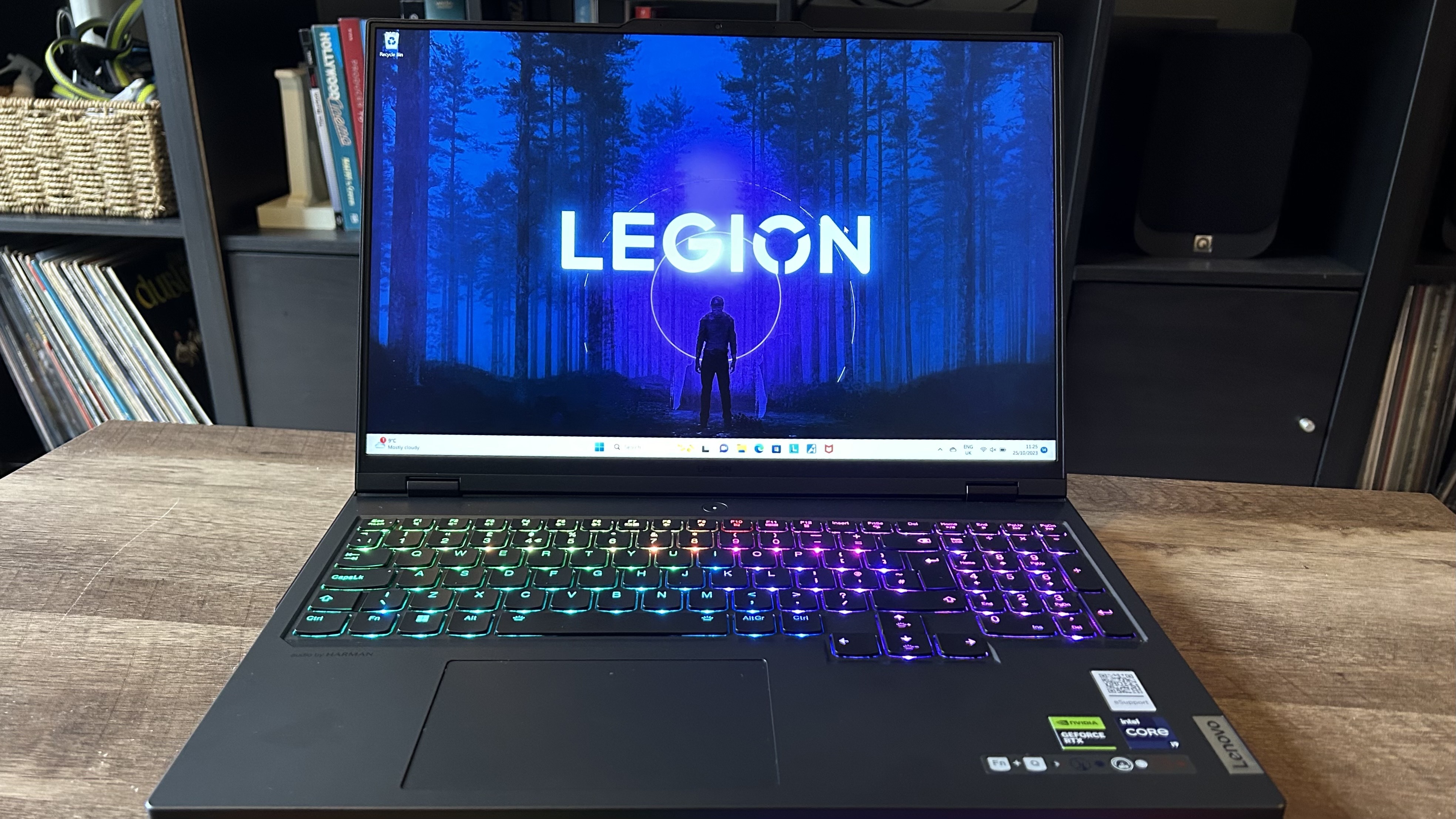
With its square shape and simple matte black aesthetic, the Pro 7i could pass for a business ultrabook without the glossy Legion branding in the top left corner of the lid (and the RGB underglow running along the front lip). This is an understated design in its physical form factor, there's no RGB on the back, no massive grills running around the sides, and not a single diagonal line to be seen. That's refreshing for those after a more grown up aesthetic in their setup, though of course that gamer flair is just one click away.
Similar to the Asus ROG Strix Scar 16, the Legion Pro 7i adds a downward facing RGB strip along the front. Both create a crisp, bright underglow effect, but Lenovo's implementation feels a lot more refined. Rather than bleeding out through the sides, this is a simple, thin strip of light hiding under the main lip of the device. While the Scar 16 felt like overkill in the RGB department, Lenovo manages to keep it suave.
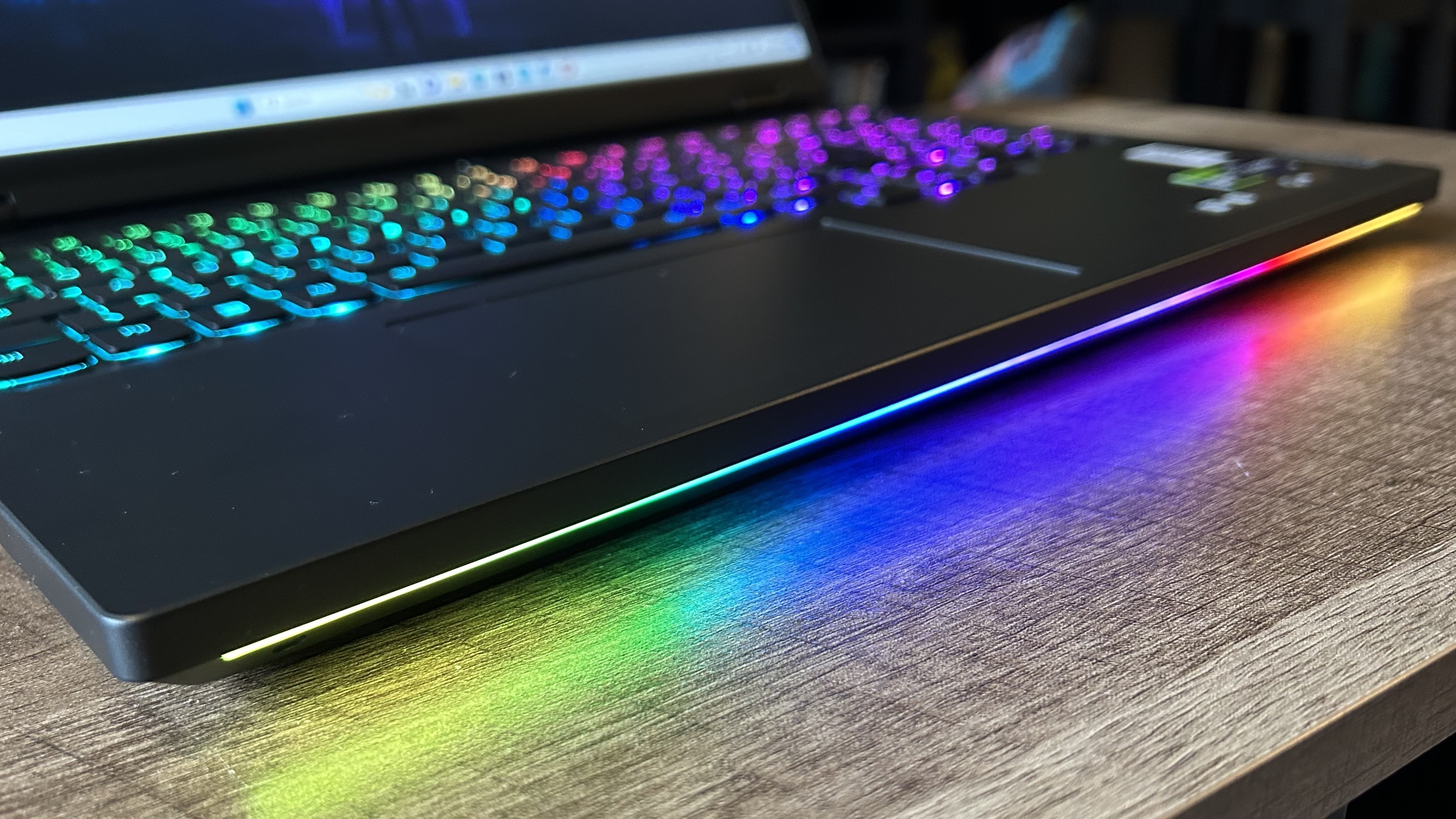
The chassis is constructed of aluminum, as one would expect from a high-end machine, and does carry the weight of a luxury device. At 2.79kg it's heavier than the Scar 16 and the HP Omen Transcend 16, though doesn't hit the heights of the chunkier Alienware M16. That's all to say, it remains nicely portable should you have a laptop backpack sturdy enough to keep a slightly higher weight comfortable. Of course, you're always going to be trading between power and portability in this 16-inch realm and the Legion strikes a nice balance overall.
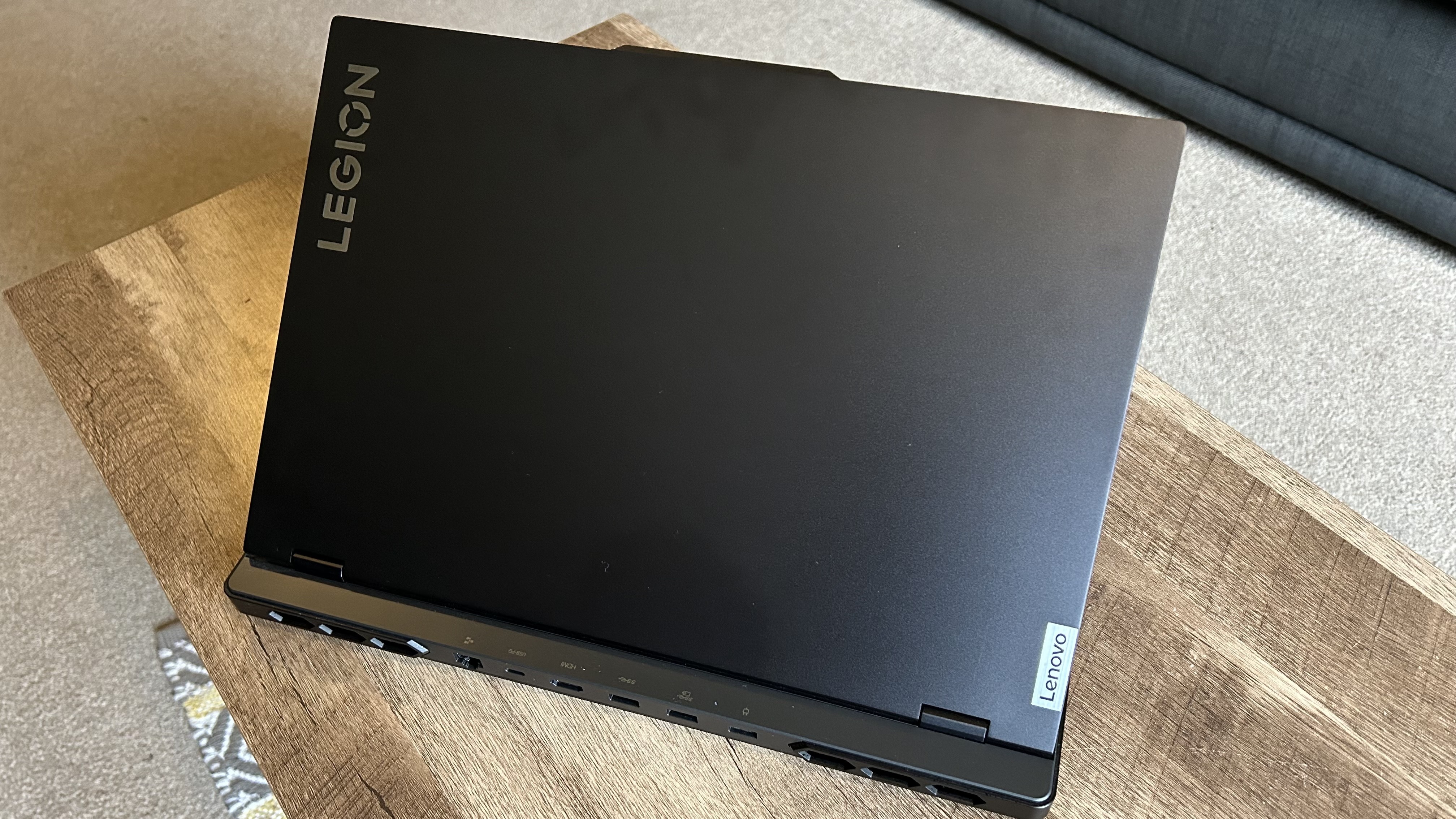
The upside is the dense machine feels incredibly sturdy in-hand. There's no flex or wobble to the lid - impressive considering the vast majority of gaming laptops that cross my desk have at least some movement here. The base itself does have a little more give to it than you'll find in a Razer laptop, for example. In fact, my only concern around the build quality lies in this base panel, and the keyboard in particular. There's a significant amount of flex to this deck and it's immediately noticeable. While it doesn't bounce too far as to interrupt typing, it certainly gives an extra mushy feel to the typing experience - one I wouldn't expect to see in a laptop at this price point. This thing will bend with a simple one finger nudge.
The lid itself opens up just above an extended rear panel. This section is dedicated to cooling and houses a bunch of ports for easy desk-based access. It's a design that's becoming more common in gaming laptops today, though if you're looking to keep the footprint as small as possible that extra ledge might be something to consider. It's by no means as egregious as an Alienware laptop, but it's still extra space taken up.
Features
Flipping that lid open, we're greeted with a super bright 240Hz display. The colors and contrast on this panel are impressive, especially considering it's not a Mini LED like many in these upper price regions. Its quality makes the experience of staring at this slightly larger 16-inch panel far more immersive than I've seen in other models, with crisp picture and excellent motion handling.

Variable refresh rate support means you can keep your system running exactly as it needs to, but pushing things up to 240Hz also means this system can really draw out the best from the RTX 40-Series components it houses. It's not quite as breathtaking as the Nebula HDR display I enjoyed so much on the Asus ROG Zephyrus M16, but it's certainly a sight to behold and the matte coating doesn't get in the way of color definition nearly as much as it does on the Alienware M18. You've also got the option to output to up to three 4K gaming monitors with a 60Hz refresh rate.
Underneath the screen you'll find a full-sized RGB keyboard with per-key lighting. Each keycap is shaped with a neat curve which kept my fingers exactly where they needed to be both in typing and gaming. I was, however, let down by this deck. Yes, it's fast, and you're getting a number pad included, full-sized arrow keys, and media playback legends mapped to navigational buttons. It's all there in terms of functionality. But the feel doesn't live up to others in this price category. The keys themselves have an ever so slightly tactile feel to the press, but the aforementioned flex in the main chassis is difficult to overlook.
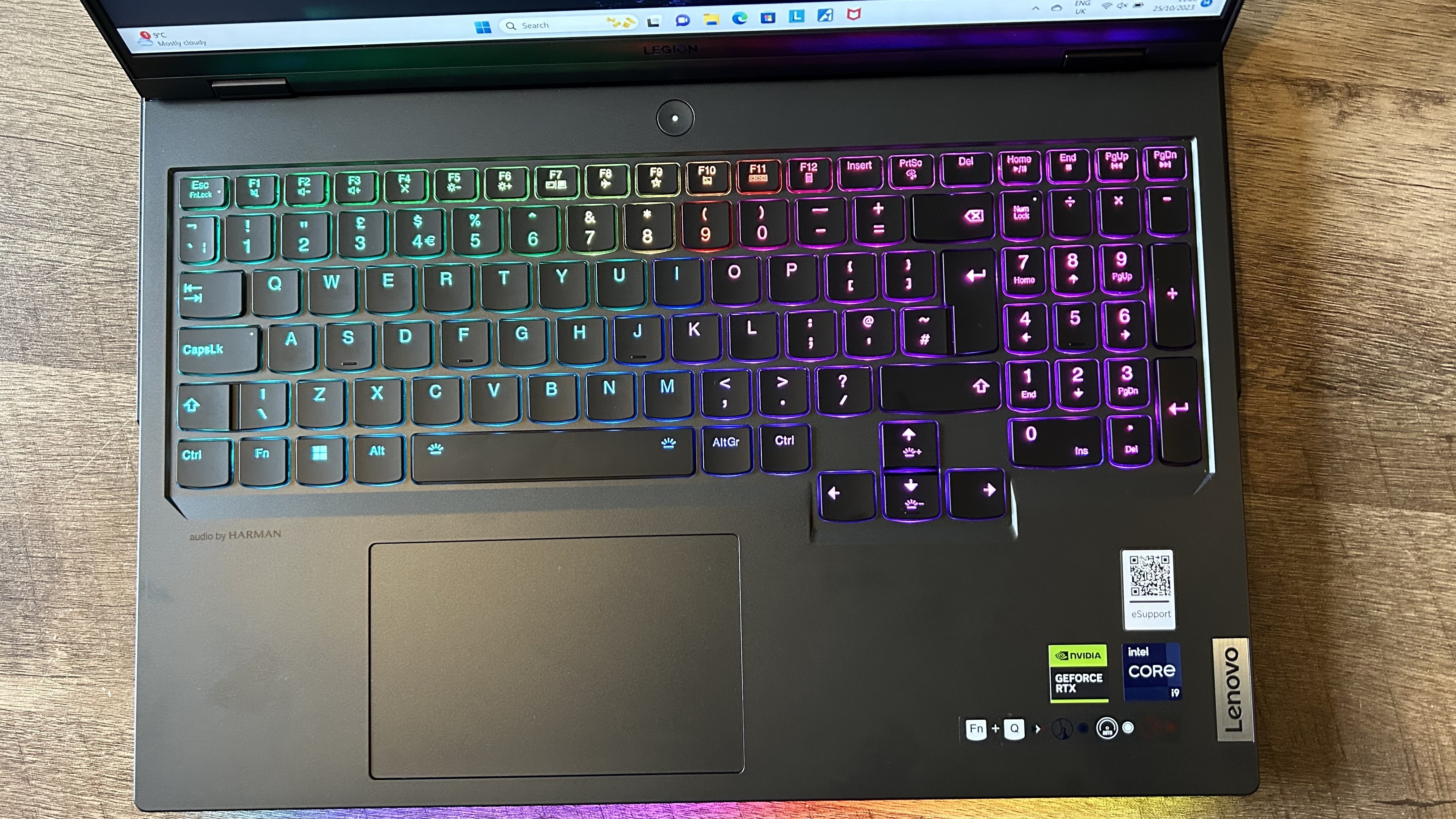
You are, however, getting a solid collection of ports. Both the left and right sides offer USB-A connections with a Thunderbolt 4 USB-C on the left and a 3.5mm audio out on the right. On top of that, the rear panel houses a plethora of additional options, another two USB-As, HDMI 2.1, USB-C 3.2 with power delivery, and an Ethernet jack. That's far more than you'll find on the Asus ROG Strix Scar 16, even if you are swapping the microSD card reader for a wired internet supply. Only the Alienware M16 comes close to this level of connectivity, though drops two of those USB-A connections for a mini-Display port instead. If you don't want to rely on a dock for all your accessories, the Legion Pro 7i is the way to go.

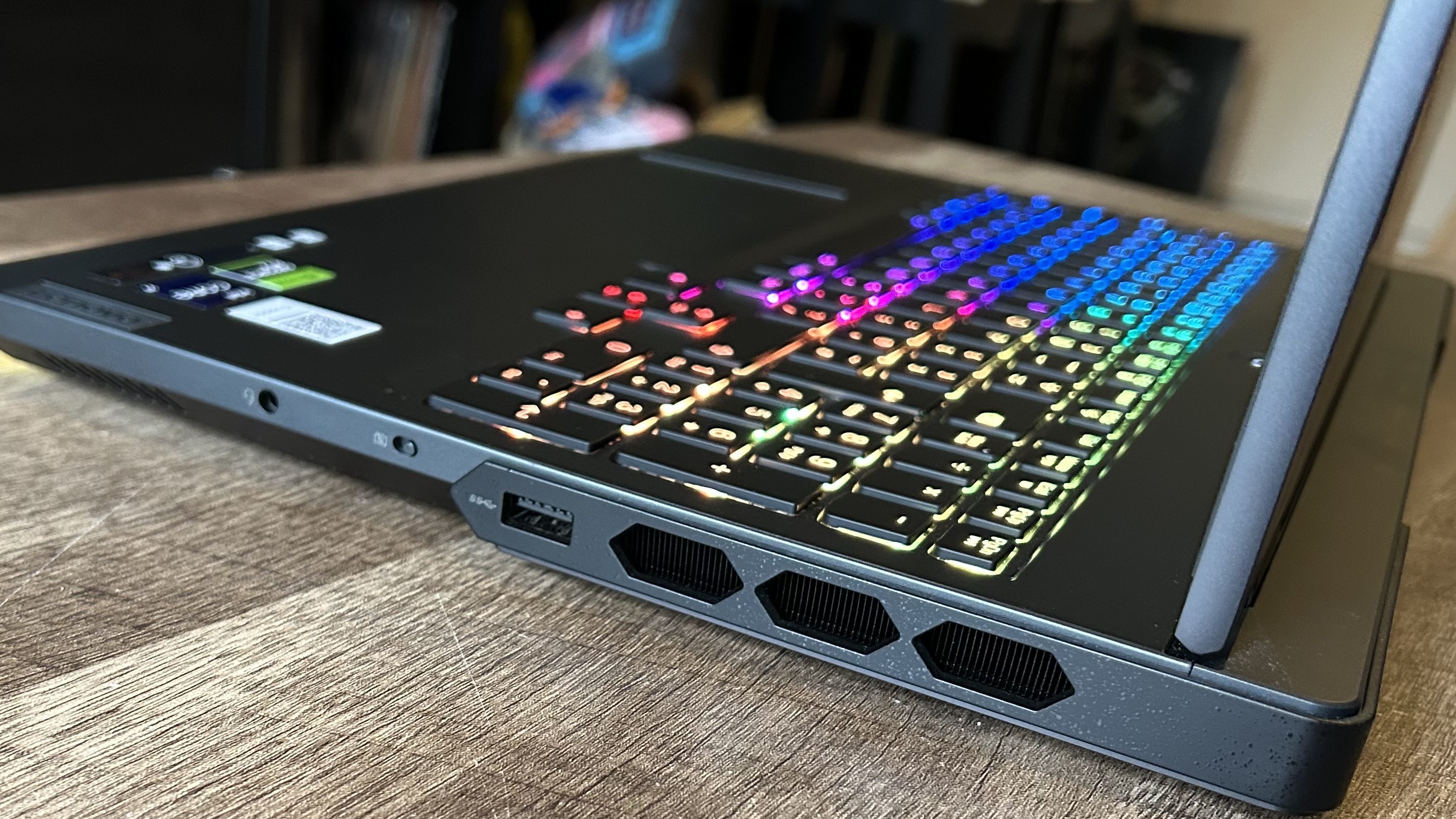

Elsewhere, you'll also find a 1080p webcam (still a rare find in gaming laptops which often opt for barely workable 720p models). Lenovo's taken this even further as well, with support for Tobii Horizon head tracking. This software uses the webcam to do what it says on the tin - track your head for input in a selection of compatible games. No, this isn't going to make or break your purchase decision, but if you do want to test out one of the 175-odd games that support the feature (including Flight Simulator, Far Cry 6, F1 23, and Assassin's Creed Valhalla) it's a welcome bonus.
Under the hood, you'll find a suite of high end components. At its base configuration, the Lenovo Legion Pro 7i pairs an Intel i9-13900HX CPU with an RTX 4070 graphics card, 16GB RAM and a 512GB SSD. That spec will cost you $2,299 - for comparison, a like-for-like model of the Alienware M16 packs a 1TB SSD into a $2,249.99 price tag - so we're at the high end of reasonable here.
Of course, you can push that up to an RTX 4090 GPU, 32GB RAM, and 2TB of SSD storage split across two drives. This is my test unit's spec, though with only a single SSD, and it comes out at $3,523.99 at Lenovo direct. That's impressive considering Asus halves your RAM (though doubles your storage) for the same spec at $3,699.99. Overall, the Lenovo Legion Pro 7i is on the right side of the price line - especially in the realms of high end configurations.
Performance
Time Spy: 14,897
Fire Strike: 29,105
PCMark 10: 7,136
Cinebench R23 (Multi): 1,248
Crystal Disk Mark: 7,125 MB/s read / 6,486 MB/s write
The Lenovo Legion Pro 7i can fly, and while it didn't quite top the benchmark numbers of the Asus ROG Strix Scar 18 (the most powerful gaming laptop we've tested yet) it certainly held its own in the 16-inch category. In a balanced power mode it nudged higher up the scale than the Asus ROG Zephyrus M16 running the same internal configuration, which trades out a more portable chassis for, on average, 10% lower framerates in 1080p. The Lenovo, however, couldn't keep up with the ROG Strix Scar 16's output, despite utilizing an RTX 4090 GPU - a step up from the RTX 4080 we benchmarked the Scar with.
Time Spy and Fire Strike scores were on the lower side of average for an RTX 4090 model, despite multiple runs. After checking everything was updated and secure, I was still unable to push past 15,000 in Time Spy or 30,000 in Fire Strke, which I would expect to see in a configuration of this caliber. That's a little disappointing on paper, but considering you're still getting easy three figure framerates in-game (at 1600p and Ultra settings for the vast majority of games) there's still plenty of power under the hood.
I would be interested to see how an RTX 4080 machine fares, though, considering we're already getting 4080-level power out of this 4090 build. In fact, the Legion Pro 7i is potentially a case against the RTX 4090 in mobile form altogether. Cheaper graphics cards are easily capable of these numbers in the right machine, and considering the (still powerful) Intel i9-13900HX CPU at the helm it's easy to wonder exactly what's needed to draw that top end power out of the GPU.
Bumping things up to performance mode did net a vast improvement in these scores, with Time Spy coming in at an even 20,000 and Fire Strike hitting 32,639. As the name suggests, that was with fans blaring, so if you're going to be pushing this rig to its limits you'll need a gaming headset to keep you in the zone.
There is a secret weapon here, though. Balanced mode opens you up to Lenovo's AI Engine+. Working with the LA-2Q AI chip, the machine can tailor its power output to the demands being placed on the system. That means variable refresh rates but also fan speeds for a finely tuned level of performance.
| Row 0 - Cell 0 | 1080p | 1600p |
| Shadow of the Tomb Raider | High: 187fps | Highest: 178fps | High: 159fps | Highest: 148fps |
| Total War: Three Kingdoms | High: 172fps | Ultra: 131fps | High: 109fps | Ultra: 80fps |
| Returnal | High: 146fps | Epic: 118fps | High: 132fps | Epic: 117fps |
| Hitman 3 | High: 154fps | Ultra: 137fps | High: 124fps | Ultra: 119fps |
| Rainbow Six Extraction | High: 219fps | Ultra: 201fps | High: 178fps | Ultra: 141fps |
Should you buy the Lenovo Legion Pro 7i?
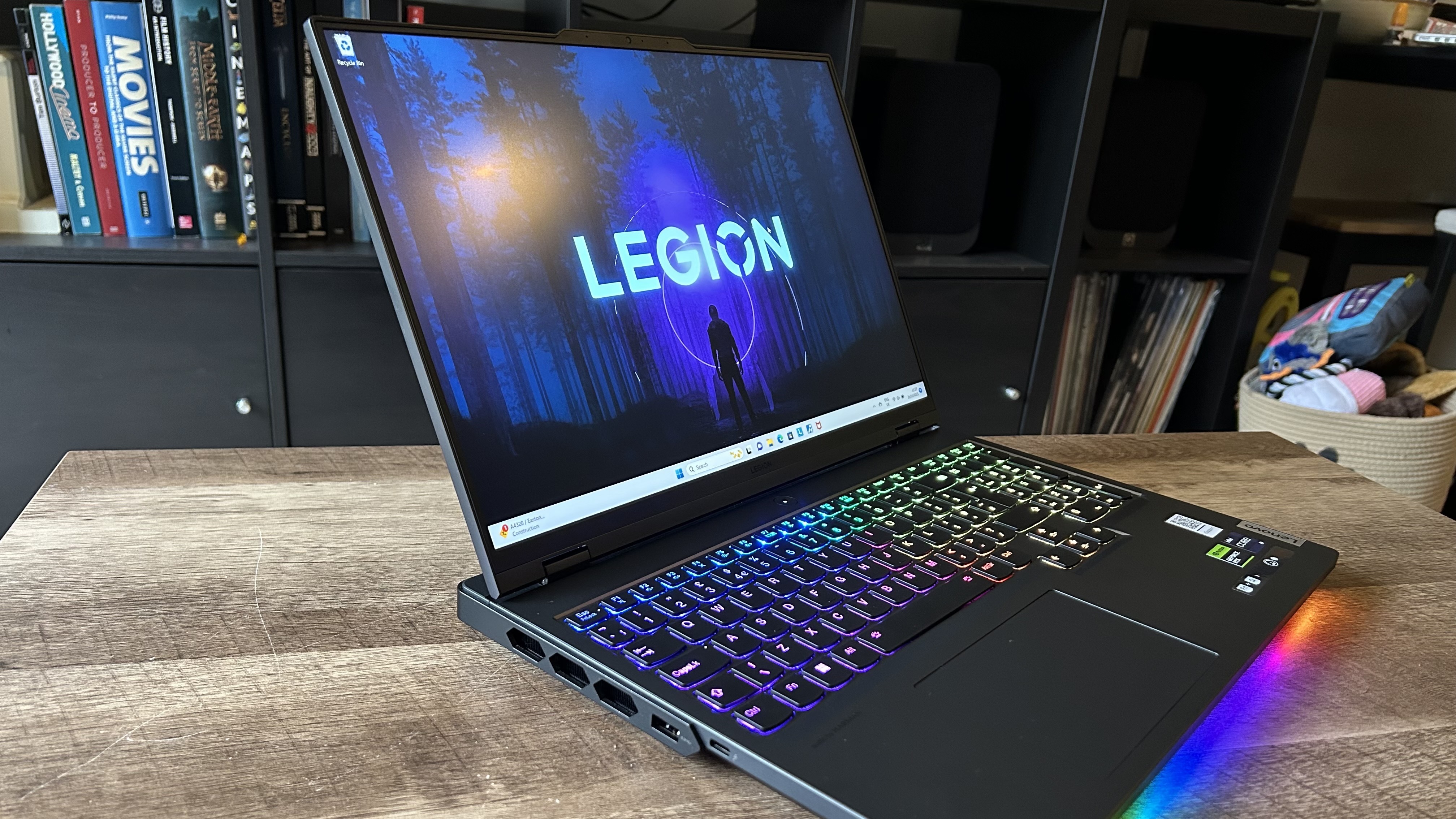
The Lenovo Legion Pro 7i is a solid piece of kit with plenty of bells and whistles hidden under one of the fairer prices in the world of high-end gaming laptops. If you're investing in a long-term solution, this is certainly one of the most cost effective ways to pick up an RTX 4080 or RTX 4090 GPU without making chassis or cooling sacrifices. It's by no means cheap, but compared to the machines it's squaring up to in the performance and display categories you're getting excellent value for money overall. This is a gorgeous machine, but it's best suited to a mid-range spec. The RTX 4090 in my testing unit didn't quite have the space it needed to truly let loose, and was offering up numbers more telling of a cheaper GPU. I'd still recommend the Lenovo Legion 7i to anyone after a current-gen 16-inch gaming laptop, but would opt for a lesser GPU under the hood. That way you're playing to both of the Legion's strengths; excellent performance in the right power mode and an affordable price tag.
How we tested the Lenovo Legion Pro 7i
I used the Lenovo Legion Pro 7i for all my daily work and play over the course of one month. In that time I played Starfield, Arcade Paradise, Doom Eternal, and Eastward during my own testing, while also benchmarking across Shadow of the Tomb Raider, Total War: Three Kingdoms, Returnal, Hitman 3, and Rainbow Six Extraction. For more information on how we test gaming laptops, check out the full GamesRadar+ Hardware Policy.
We're also rounding up all the best Asus gaming laptops on the market. Or, for something a little more portable check out the best gaming PCs and the best Alienware PCs available now.

Managing Editor of Hardware at GamesRadar+, I originally landed in hardware at our sister site TechRadar before moving over to GamesRadar. In between, I've written for Tom’s Guide, Wireframe, The Indie Game Website and That Video Game Blog, covering everything from the PS5 launch to the Apple Pencil. Now, i'm focused on Nintendo Switch, gaming laptops (and the keyboards, headsets and mice that come with them), PS5, and trying to find the perfect projector.



